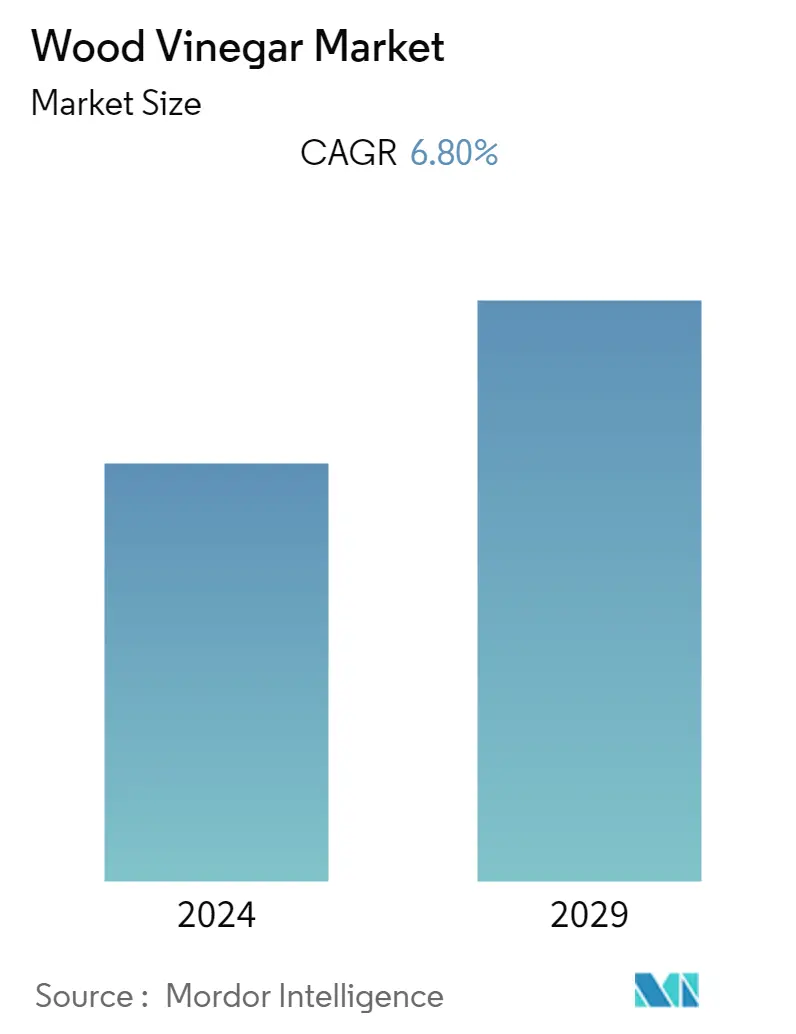Market Size of Wood Vinegar Industry

| Study Period | 2019 - 2029 |
| Base Year For Estimation | 2023 |
| CAGR | 6.80 % |
| Fastest Growing Market | South America |
| Largest Market | Asia Pacific |
| Market Concentration | Low |
Major Players
*Disclaimer: Major Players sorted in no particular order |
Wood Vinegar Market Analysis
The Global Wood Vinegar Market is projected to grow at a CAGR of 6.8% during the forecast period.
With the increased acceptance of global cuisines, the market for wood vinegar has expanded globally since it has an acrid smoky odor, typical to food products such as barbeque sauce, which is gaining global acceptance. Further, it is being increasingly used in canned food products as a preservative, owing to its anti-microbial and antioxidant properties. The ingredient is finding its application in the food preservation sector in meat, fish, and other food industries across the globe.
Further, wood vinegar has a growing acceptance as a biofertilizer and a biopesticide in agriculture, which is booming due to the prevailing high demand for organic food products by consumers. It is also used as a wood preservative and acts against termiticidal activities. Wood vinegar is also used in the cosmetics and pharmacy industry, having applications in deodorants, soaps, sunscreen creams, treatment of dandruff and eczema, and others.
Also, the high consumption of meat among the consumers has resulted in livestock farmers using wood vinegar in animal feed supplements to lower the cholesterol level while maintaining the quality of meat. As cholesterol has remained a growing concern among consumers, this factor is actively driving the wood vinegar market in the animal feed industry. In fact, wood vinegar is known to help balance bacterial level in digestive tract of animals, therbey, maintaining healthy livestock, inturn, increasing the demand further.
Wood Vinegar Industry Segmentation
Wood vinegar is a red-brown liquid that is prepared by the distillation of wood, containing acetic acid, methanol, acetone, wood oil, and tars. The market study covers segmentation by application and geography. On the basis of application, the market is segmented into agriculture, food & beverage, animal feed, and other applications. The agricultural application is further segmented into crop nutrition and crop protection, and food & beverage is further bifurcated into canned food, sauces, dairy products, and other food & beverages. The market is segmented by geography into North America, Europe, Asia-Pacific, South America, Middle East & Africa. For each segment, the market sizing and forecasts have been done based on value (in USD million).
| Application | ||||||
| ||||||
| ||||||
| Animal Feed | ||||||
| Other Applications |
| Geography | |||||||||
| |||||||||
| |||||||||
| |||||||||
| |||||||||
|
Wood Vinegar Market Size Summary
The global wood vinegar market is experiencing significant growth, driven by its expanding applications across various industries. The increasing acceptance of global cuisines has boosted the demand for wood vinegar, particularly in food preservation, where its antimicrobial and antioxidant properties are valued. This ingredient is gaining traction in the food industry for preserving meat, fish, and other products. Additionally, wood vinegar is finding new applications in agriculture as a biofertilizer and biopesticide, aligning with the rising consumer demand for organic food products. Its use as a wood preservative and in cosmetics and pharmacy products further diversifies its market potential. The livestock sector also benefits from wood vinegar, as it is used in animal feed supplements to reduce cholesterol levels and maintain meat quality, thereby supporting healthy livestock.
The market's growth is further fueled by the increasing practice of organic farming, which drives the demand for organic fertilizers and pesticides like wood vinegar. This natural product is effective for both crop nutrition and protection, making it suitable for sustainable agriculture. Government support and the emphasis on regenerative agriculture and soil health are additional factors propelling the market. In regions like Asia, where agriculture is a significant part of the economy, wood vinegar is enhancing crop yields and quality, encouraging more farmers to adopt organic practices. The market is characterized by fragmentation, with numerous regional players employing strategies such as partnerships and expansions to enhance their global presence. Key players are also focusing on launching new offerings and exploring potential markets, contributing to the dynamic growth of the wood vinegar market.
Wood Vinegar Market Size - Table of Contents
-
1. MARKET DYNAMICS
-
1.1 Market Drivers
-
1.2 Market Restraints
-
1.3 Porter's Five Forces Analysis
-
1.3.1 Threat of New Entrants
-
1.3.2 Bargaining Power of Buyers/Consumers
-
1.3.3 Bargaining Power of Suppliers
-
1.3.4 Threat of Substitute Products
-
1.3.5 Intensity of Competitive Rivalry
-
-
-
2. MARKET SEGMENTATION
-
2.1 Application
-
2.1.1 Agriculture
-
2.1.1.1 Crop Nutrition
-
2.1.1.2 Crop Protection
-
-
2.1.2 Food & Beverage
-
2.1.2.1 Canned Food
-
2.1.2.2 Sauces
-
2.1.2.3 Dairy Products
-
2.1.2.4 Other Food & Beverage Applications
-
-
2.1.3 Animal Feed
-
2.1.4 Other Applications
-
-
2.2 Geography
-
2.2.1 North America
-
2.2.1.1 United States
-
2.2.1.2 Canada
-
2.2.1.3 Mexico
-
2.2.1.4 Rest of North America
-
-
2.2.2 Europe
-
2.2.2.1 Germany
-
2.2.2.2 United Kingdom
-
2.2.2.3 France
-
2.2.2.4 Spain
-
2.2.2.5 Russia
-
2.2.2.6 Italy
-
2.2.2.7 Rest of Europe
-
-
2.2.3 Asia-Pacific
-
2.2.3.1 China
-
2.2.3.2 India
-
2.2.3.3 Japan
-
2.2.3.4 Australia
-
2.2.3.5 Rest of Asia-Pacific
-
-
2.2.4 South America
-
2.2.4.1 Brazil
-
2.2.4.2 Argentina
-
2.2.4.3 Rest of South America
-
-
2.2.5 Middle East & Africa
-
2.2.5.1 Saudi Arabia
-
2.2.5.2 South Africa
-
2.2.5.3 Rest of Middle East & Africa
-
-
-
Wood Vinegar Market Size FAQs
What is the current Wood Vinegar Market size?
The Wood Vinegar Market is projected to register a CAGR of 6.80% during the forecast period (2024-2029)
Who are the key players in Wood Vinegar Market?
Tagrow Co. LTD, Nettenergy B.V., Ace (Singapore) Pte Ltd, PyroAg Wood Vinegar and Merck KGaA are the major companies operating in the Wood Vinegar Market.

